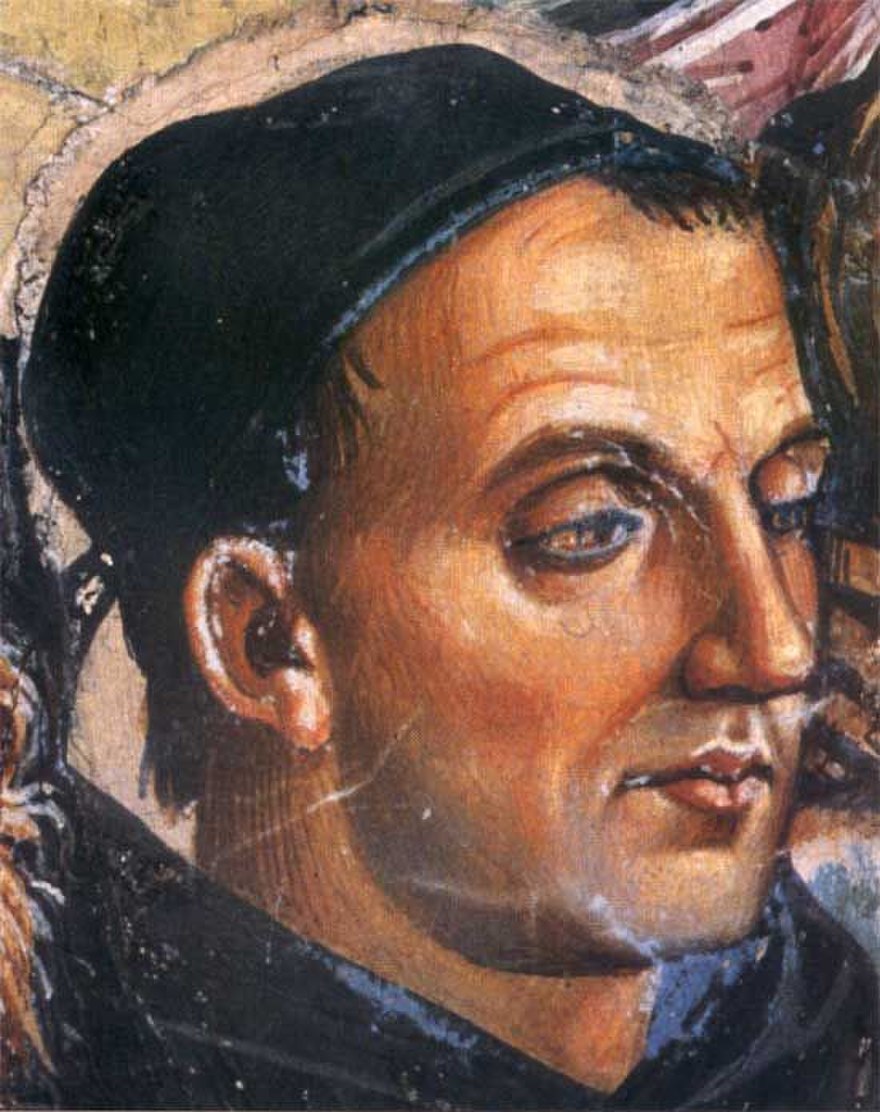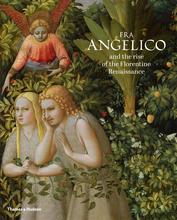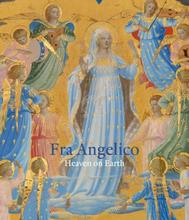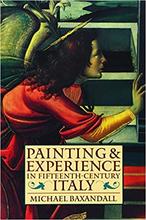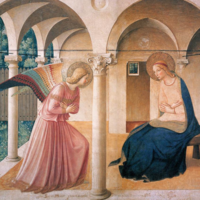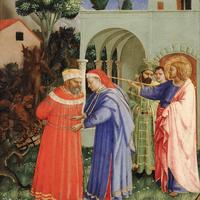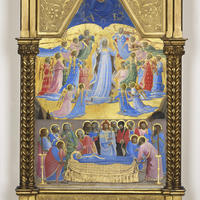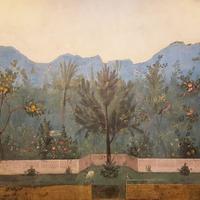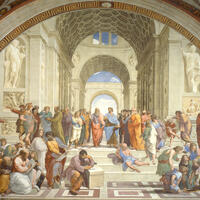More about Fra Angelico
- All
- Info
- Shop

Contributor
Guido di Pietro, who was posthumously referred to as Fra Angelico, was one of the best Italian Renaissance painters but he was an even better Catholic.
Critics don’t agree on when Fra Angelico was born but it was definitely somewhere around the 1390’s...probably. No one knows who his parents were but they had three children and were probably rich because they could afford to give their kids an art education. Angelico apprenticed with Lorenzo Monaco, a manuscript illuminator, and was deemed a star on the rise in his artistic pursuits. He started getting commissions but instead of joining an artist’s guild and making serious amounts of money, Angelico decided to join the convent of San Domenico as a friar. This was not just any convent. It was “specifically a back-to-basics Observant branch in Fiesole, with an in-town base at the monastery of San Marco,” which has since become like a Fra Angelico fan’s Mecca.
He joined up with his brother, Fra Benedetto, who was also an artist, and got a cool new friar name, Fra Giovanni da Fiesole. He and his brother had a full on workshop going on there by the 1430s and got commissions from people as esteemed as Cosimo de’ Medici and Palla Strozzi. And even though his patrons were absolutely and completely loaded, Fra Angelico abstained from wealth. He also probably engaged in self-flagellation and fasting, as were the trends of Catholicism at the time. He was so religious in fact that one of his biographers, Giorgio Vasari, said that Fra Angelico most likely couldn’t paint a crucifix without crying.
Fra Angelico's work bridged the gap between the Late Gothic and the Renaissance, depicting traditional religious subject matter in altarpieces and frescoes but incorporating new innovations in perspective, figure modeling, and naturalistic backgrounds. When Masaccio, the young artist who trailblazed perspective, died in 1428, Fra Angelico would become the most important artist working in Florence.
In the 1445, Angelico got the best gig of his career. He was called to Rome by Pope Eugenius IV to decorate some rooms in the Vatican Palace. Everyone was super behind the summoning of Angelico to Rome and praised the pope in the streets for his choice, saying, “Eugenius, you genius!” (I understand this was a long way to go for a joke, but no regrets). This was probably the deciding factor between Angelico or Benedetto going down in history as a famous artist, but that’s just how the Communion crumbles. Angelico didn’t stay long and was back at San Domenico by around 1450. He only returned to Rome one more time before he passed away in 1455.
Death did nothing to stop Fra Angelico from becoming even more famous. He was one of the great inspirations of the Pre-Raphaelite Brotherhood. Artists like Dante Gabriel Rossetti looked to him for subject matter and palette inspiration. And then in 1982, Fra Angelico was beatified by Pope John Paul II. And that’s when you know you’re good.
Sources
- Cotter, Holland. "Review: Art For The Soul In ‘Fra Angelico: Heaven On Earth’." Nytimes.com. N.p., 2018. Web. 7 Nov. 2018. https://www.nytimes.com/2018/05/16/arts/design/review-fra-angelico-heav…
- Festorazzi, Libby. "Fra Angelico's Life And Legacy." The Art Story. N.p., 2018. Web. 7 Nov. 2018. https://www.theartstory.org/artist-fra-angelico-life-and-legacy.htm
- Kimmelman, Michael. "Fra Angelico, The Master Of The Golden Halo." Nytimes.com. N.p., 2005. Web. 7 Nov. 2018. https://www.nytimes.com/2005/09/11/arts/design/fra-angelico-the-master-…
- Salmi, Mario. "Fra Angelico | Biography, Art, & Facts." Encyclopedia Britannica. N.p., 2018. Web. 7 Nov. 2018. https://www.britannica.com/biography/Fra-Angelico
- Finocchio, Ross. “Fra Angelico (Guido di Pietro) (ca. 1395–1455).” In Heilbrunn Timeline of Art History. New York: The Metropolitan Museum of Art, 2000–. http://www.metmuseum.org/toah/hd/fang/hd_fang.htm (October 2006) RELATED The Crucifixion and Passion

Featured Books & Academic Sources
The following excerpts are from "Lives of the Most Eminent Painters, Sculptors and Architects, Vol. 3, Filarete and Simone to Mantegna" by Giorgio Vasari, originally published in 1550:
Fra Giovanni Angelico da Fiesole, who was known in the world as Guido, was no less excellent as painter and illuminator than he was upright as churchman, and for both one and the other of these reasons he deserves that most honourable record should be made of him. This man, although he could have lived in the world with the greatest comfort, and could have gained whatever he wished, besides what he possessed, by means of those arts, of which he had a very good knowledge even in his youth, yet resolved, for his own peace and satisfaction, being by nature serious and upright, and above all in order to save his soul, to take the vows of the Order of Preaching Friars; for the reason that, although it is possible to serve God in all walks of life, nevertheless it appears to some men that they can gain salvation in monasteries better than in the world. Now in proportion as this plan succeeds happily for good men, so, on the contrary, it has a truly miserable and unhappy issue for a man who takes the vows with some other end in view.
There are some choral books illuminated by the hand of Fra Giovanni in his Convent of S. Marco in Florence, so beautiful that words are not able to describe them; and similar to these are some others that he left in S. Domenico da Fiesole, wrought with incredible diligence. It is true, indeed, that in making these he was assisted by an elder brother, who was likewise an illuminator and well practised in painting.
One of the first works in painting wrought by this good father was a panel in the Certosa of Florence, which was placed in the principal chapel (belonging to Cardinal Acciaiuoli); in which panel is a Madonna with the Child in her arms, and with certain very beautiful angels at her feet, sounding instruments and singing; at the sides are S. Laurence, S. Mary Magdalene, S. Zanobi, and S. Benedict; and in the predella are little stories of these Saints, wrought in little figures with infinite diligence. In the cross of the said chapel are two other panels by the hand of the same man; one containing the Coronation of Our Lady, and the other a Madonna with two saints, wrought with most beautiful ultramarine blues. Afterwards, in the tramezzo of S. Maria Novella, beside the door opposite to the choir, he painted in fresco S. Dominic, S. Catherine of Siena, and S. Peter Martyr; and some little scenes in the Chapel of the Coronation of Our Lady in the said tramezzo. On canvas, fixed to the doors that closed the old organ, he painted an Annunciation, which is now in the convent, opposite to the door of the lower dormitory, between one cloister and the other.
This father was so greatly beloved for his merits by Cosimo de' Medici, that, after completing the construction of the Church and Convent of S. Marco, he caused him to paint the whole Passion of Jesus Christ on a wall in the chapter-house; and on one side all the Saints who have been heads and founders of religious bodies, mourning and weeping at the foot of the Cross, and on the other side S. Mark the Evangelist beside the Mother of the Son of God, who has swooned at the sight of the Saviour of the world Crucified, while round her are the Maries, all grieving and supporting her, with S. Cosimo and S. Damiano. It is said that in the figure of S. Cosimo Fra Giovanni portrayed from the life Nanni d' Antonio di Banco, a sculptor and his friend. Below this work, in a frieze above the panelling, he made a tree with S. Dominic at the foot of it, and, in certain medallions encircled by the branches, all the Popes, Cardinals, Bishops, Saints, and Masters of Theology whom his Order of Preaching Friars had produced up to that time. In this work he made many portraits from nature, being assisted by the friars, who sent for them to various places; and they were the following: S. Dominic in the middle, grasping the branches of the tree; Pope Innocent V, a Frenchman; the Blessed Ugone, first Cardinal of that Order; the Blessed Paolo, Florentine and Patriarch; S. Antonino, Archbishop of Florence; the Blessed Giordano, a German, and the second General of that Order; the Blessed Niccolò; the Blessed Remigio, a Florentine; and the martyr Boninsegno, a Florentine; all these are on the right hand. On the left are Benedict II of Treviso; Giandomenico, a Florentine Cardinal; Pietro da Palude, Patriarch of Jerusalem; Alberto Magno, a German; the Blessed Raimondo di Catalonia, third General of the Order; the Blessed Chiaro, a Florentine, and Provincial of Rome; S. Vincenzio di Valenza; and the Blessed Bernardo, a Florentine. All these heads are truly gracious and very beautiful. Then, over certain lunettes in the first cloister, he made many very beautiful figures in fresco, and a Crucifix with S. Dominic at the foot, which is much extolled; and in the dormitory, besides many other things throughout the cells and on the surface of the walls, he painted a story from the New Testament, of a beauty beyond the power of words to describe. Particularly beautiful and marvellous is the panel of the high-altar of that church; for, besides the fact that the Madonna rouses all who see her to devotion by her simplicity, and that the Saints that surround her are like her in this, the predella, in which there are stories of the martyrdom of S. Cosimo, S. Damiano, and others, is so well painted, that one cannot imagine it possible ever to see a work executed with greater diligence, or little figures more delicate or better conceived than these are.
In S. Domenico da Fiesole, likewise, he painted the panel of the high-altar, which has been retouched by other masters and injured, perchance because it appeared to be spoiling. But the predella and the Ciborium of the Sacrament have remained in better preservation; and the innumerable little figures that are to be seen there, in a Celestial Glory, are so beautiful, that they appear truly to belong to Paradise, nor can any man who approaches them ever have his fill of gazing on them. In a chapel of the same church is a panel by his hand, containing the Annunciation of Our Lady by the Angel Gabriel, with features in profile, so devout, so delicate, and so well executed, that they appear truly to have been made rather in Paradise than by the hand of man; and in the landscape at the back are Adam and Eve, because of whom the Redeemer was born from the Virgin. In the predella, also, there are some very beautiful little scenes.
But superior to all the other works that Fra Giovanni made, and the one wherein he surpassed himself and gave supreme proof of his talent and of his knowledge of art, was a panel that is beside the door of the same church, on the left hand as one enters, wherein Jesus Christ is crowning Our Lady in the midst of a choir of angels and among an infinite multitude of saints, both male and female, so many in number, so well wrought, and with such variety in the attitudes and in the expressions of the heads, that incredible pleasure and sweetness are felt in gazing at them; nay, one is persuaded that those blessed spirits cannot look otherwise in Heaven, or, to speak more exactly, could not if they had bodies; for not only are all these saints, both male and female, full of life and sweet and delicate in expression, but the whole colouring of that work appears to be by the hand of a saint or an angel like themselves; wherefore it was with very good reason that this excellent monk was ever called Fra Giovanni Angelico. Moreover, the stories of the Madonna and of S. Dominic in the predella are divine in their own kind; and I, for one, can declare with truth that I never see this work without thinking it something new, and that I never leave it sated...
...Great excellence was that of Fra Giovanni, and a thing truly very rare, to resign a dignity and honour and charge so important, offered to himself by a Supreme Pontiff, in favour of the man whom he, with his singleness of eye and sincerity of heart, judged to be much more worthy of it than himself. Let the churchmen of our own times learn from this holy man not to take upon themselves charges that they cannot worthily carry out, and to yield them to those who are most worthy of them. Would to God, to return to Fra Giovanni (and may this be said without offence to the upright among them), that all churchmen would spend their time as did this truly angelic father, seeing that he spent every minute of his life in the service of God and in benefiting both the world and his neighbour. And what can or ought to be desired more than to gain the kingdom of Heaven by living a life of holiness, and to win eternal fame in the world by labouring virtuously? And in truth a talent so extraordinary and so supreme as that of Fra Giovanni could not and should not descend on any save a man of most holy life, for the reason that those who work at religious and holy subjects should be religious and holy men; for it is seen, when such works are executed by persons of little faith who have little esteem for religion, that they often arouse in men's minds evil appetites and licentious desires; whence there comes blame for the evil in their works, with praise for the art and ability that they show. Now I would not have any man deceive himself by considering the rude and inept as holy, and the beautiful and excellent as licentious; as some do, who, seeing figures of women or of youths adorned with loveliness and beauty beyond the ordinary, straightway censure them and judge them licentious, not perceiving that they are very wrong to condemn the good judgment of the painter, who holds the Saints, both male and female, who are celestial, to be as much more beautiful than mortal man as Heaven is superior to earthly beauty and to the works of human hands; and, what is worse, they reveal the unsoundness and corruption of their own minds by drawing evil and impure desires out of works from which, if they were lovers of purity, as they seek by their misguided zeal to prove themselves to be, they would gain a desire to attain to Heaven and to make themselves acceptable to the Creator of all things, in whom, as most perfect and most beautiful, all perfection and beauty have their source. What would such men do if they found themselves, or rather, what are we to believe that they do when they actually find themselves, in places containing living beauty,[Pg 34] accompanied by licentious ways, honey-sweet words, movements full of grace, and eyes that ravish all but the stoutest of hearts, if the very image of beauty, nay, its mere shadow, moves them so profoundly? However, I would not have any believe that I approve of those figures that are painted in churches in a state of almost complete nudity, for in these cases it is seen that the painter has not shown the consideration that was due to the place; because, even although a man has to show how much he knows, he should proceed with due regard for circumstances and pay respect to persons, times, and places.
Fra Giovanni was a man of great simplicity, and most holy in his ways; and his goodness may be perceived from this, that, Pope Nicholas V wishing one morning to entertain him at table, he had scruples of conscience about eating meat without leave from his Prior, forgetting about the authority of the Pontiff. He shunned the affairs of the world; and, living a pure and holy life, he was as much the friend of the poor as I believe his soul to be now the friend of Heaven. He was continually labouring at his painting, and he would never paint anything save Saints. He might have been rich, but to this he gave no thought; nay, he used to say that true riches consist only in being content with little. He might have ruled many, but he would not, saying that it was less fatiguing and less misleading to obey others. He had the option of obtaining dignities both among the friars and in the world, but he despised them, declaring that he sought no other dignity save that of seeking to avoid Hell and draw near to Paradise. And what dignity, in truth, can be compared to that which all churchmen, nay, all men, should seek, and which is to be found only in God and in a life of virtue? He was most kindly and temperate; and he lived chastely and withdrew himself from the snares of the world, being wont very often to say that he who pursued such an art had need of quiet and of a life free from cares, and that he whose work is connected with Christ must ever live with Christ. He was never seen in anger among his fellow-friars, which is a very notable thing, and almost impossible, it seems to me, to believe; and it was his custom to admonish his friends with a simple smile. With incredible sweetness, if any sought for works from him, he would say that they had only to gain the consent of the Prior, and that then he would not fail them. In short, this never to be sufficiently extolled father was most humble and modest in all his works and his discourse, and facile and devout in his pictures; and the Saints that he painted have more the air and likeness of Saints than those of any other man. It was his custom never to retouch or improve any of his pictures, but to leave them ever in the state to which he had first brought them; believing, so he used to say, that this was the will of God. Some say that Fra Giovanni would never have taken his brushes in his hand without first offering a prayer. He never painted a Crucifix without the tears streaming down his cheeks; wherefore in the countenances and attitudes of his figures one can recognize the goodness, nobility, and sincerity of his mind towards the Christian religion.
He died in 1455 at the age of sixty-eight, and left disciples in Benozzo, a Florentine, who ever imitated his manner, and Zanobi Strozzi, who painted pictures and panels throughout all Florence for the houses of citizens, and particularly a panel that is now in the tramezzo of S. Maria Novella, beside that by Fra Giovanni, and one in S. Benedetto, a monastery of the Monks of Camaldoli without the Porta a Pinti, now in ruins.
Sources
- Vasari, Giorgio. "Lives of the Most Eminent Painters Sculptors and Architects Vol. 3 (of 10), Filarete and Simone to Mantegna" (London: PHILIP LEE WARNER, PUBLISHER TO THE MEDICI SOCIETY, LIMITED) 25-35.
Featured Content
Here is what Wikipedia says about Fra Angelico
Fra Giovanni da Fiesole (Vicchio, c. 1395 – Rome, 18 February 1455), known as Fra Angelico (/ˌfrɑː ænˈdʒɛlɪkoʊ/ FRAH an-JEL-ik-oh,
Italian: [ˈfra anˈdʒɛːliko] was a Dominican friar and one of the greatest painters of the early Florentine Renaissance during the 15th century.
He earned his reputation for the series of frescoes he made for his own friary, San Marco in Florence, by comission of Cossimo de Medici 'The Elder', founder of the Medici dinasty. His masterpieces are the San Marco Altarpiece and the Deposition of Christ, both for the convent of San Marco. Fra Angelico also worked in Rome by request of two Popes and in other cities in Tuscany. All his known paintings are of religious subjects.
In 1982, Pope John Paul II beatified him in recognition of the holiness of his life and in 1984 he declared him patron of Catholic artists.
Check out the full Wikipedia article about Fra Angelico

